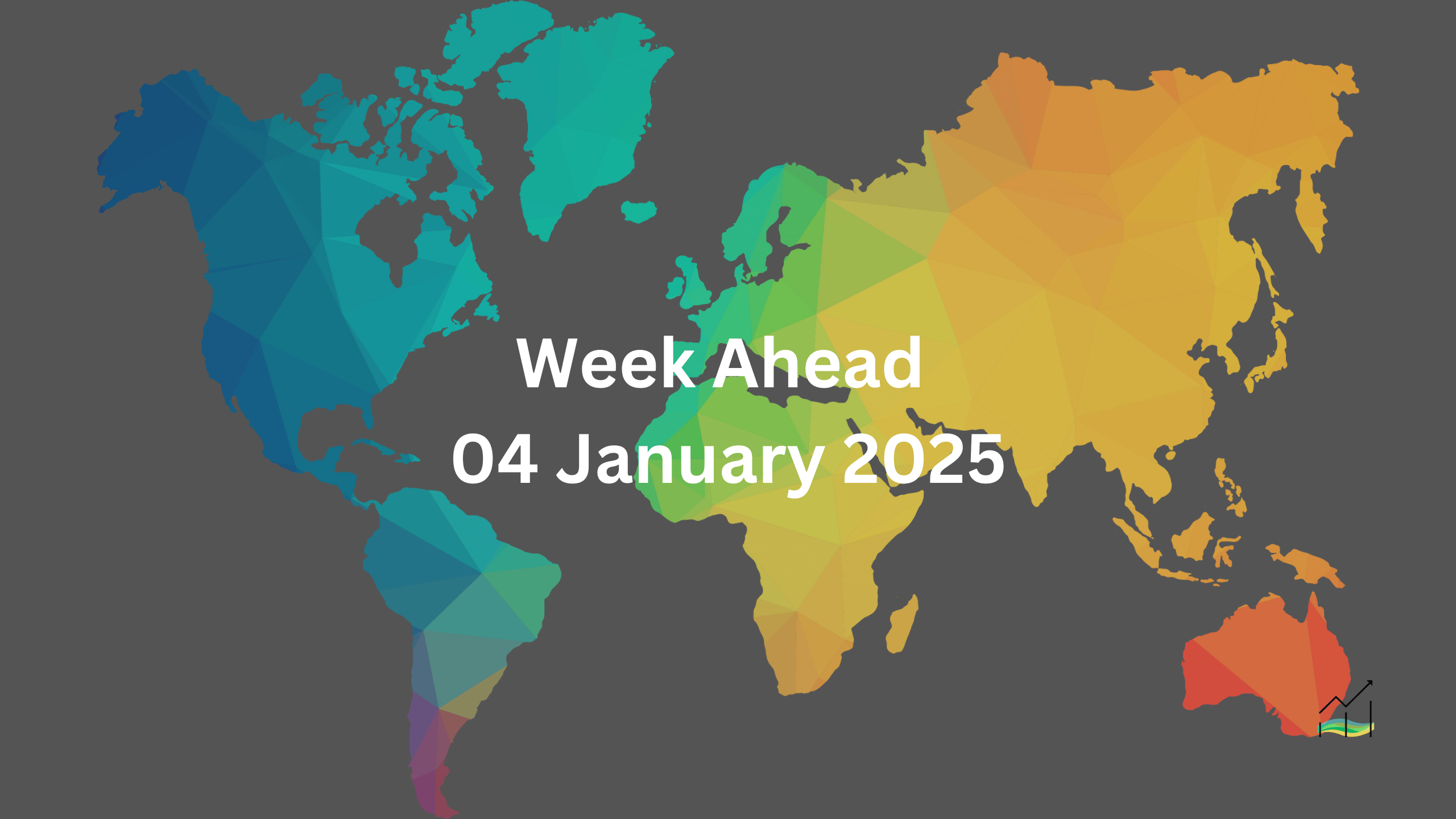04/01/2025 Market Analysis

Week Ahead: Fed Minutes, U.S. Jobs Data
As 2025 begins, a series of key economic developments will set the tone for global markets. In the U.S., critical data, including monthly jobs reports and Federal Reserve meeting minutes, will shape expectations around economic health and interest rate policy. This comes ahead of President-elect Donald Trump's inauguration on January 20. Meanwhile, the U.S. continues to outperform other major economies, driven by a significant budget deficit, productivity gains, and robust consumer spending.
In the eurozone, inflation data may bolster expectations for interest rate cuts as economic growth stagnates. Despite weak momentum, most eurozone nations remain committed to fiscal consolidation, with the aggregate budget deficit projected to dip to 2.9% in 2025. The region continues to grapple with structural challenges, including the lack of full monetary and fiscal union, compounded by political instability in key economies like France and Germany.
Japan offers a mixed outlook. Economic growth is expected to accelerate to 1.1% in 2025, supported by improved fiscal conditions and moderate inflation. However, the Bank of Japan’s ability to further normalize monetary policy is constrained by core inflation trending below its 2% target. Interest rates are projected to remain low, underscoring Japan’s unique position in the global monetary landscape.
China faces ongoing economic challenges, including subdued inflation, falling property prices, and underwhelming export performance. While consumption has grown, strong investment still dominates its economic model. Despite setbacks, China has made significant strides in critical industries like electric vehicles and solar panels, positioning itself as a major player on the global stage. Tensions with the U.S. remain high, with both countries escalating trade and technological restrictions.
The U.S. dollar surged in Q4 2024, buoyed by the Federal Reserve’s relatively less dovish stance compared to other central banks. This divergence in monetary policy has created notable interest rate differentials, favoring the greenback. Among major currencies, the Antipodeans were the weakest performers, with the New Zealand dollar declining sharply due to aggressive rate cuts. Similarly, the Australian dollar faced pressure despite stable monetary policy. The Canadian dollar, while also weaker, performed better relative to other currencies aside from the U.S. dollar.
Globally, inflation appears to have peaked in many high-income countries, and disinflationary trends persist in China. Switzerland’s inflation fell below 1% in late 2024, prompting rate cuts, with markets anticipating a return to negative rates in 2025. These dynamics reflect broader themes of fiscal and monetary policy adjustments in response to lingering global economic disruptions.
Geopolitically, tensions persist across regions. China continues to exert pressure on its neighbors, while hopes for a resolution in Ukraine are tempered by complex territorial and security considerations. In the Middle East, evolving power dynamics could either stabilize or exacerbate regional conflicts. Despite these uncertainties, 2025 begins with a mix of familiar economic challenges and opportunities, setting the stage for critical policy decisions and market movements.
United States of America
Upcoming Nonfarm Payrolls Data
This week’s spotlight will be on Friday’s nonfarm payrolls report for December, a critical indicator of employment levels and wage growth. Additionally, the Federal Reserve's minutes on Wednesday will offer valuable insights into monetary policy deliberations.
Economic Strength Shifts Rate Expectations
Recent signs of resilience in the U.S. economy have led investors to lower their expectations for interest rate cuts in 2025. Markets now anticipate only 40 basis points of cuts by year-end, a significant shift from the 150 basis points initially priced a year ago. Stronger-than-expected economic data could further diminish these expectations.
Potential Impact of Policy Announcements
President-elect Trump’s upcoming policies, including proposed trade tariffs and tax cuts, may stimulate economic growth while potentially increasing inflation. Such developments could lead to higher-than-expected interest rates, as monetary policy remains tied to inflation trends and labor market dynamics.
Dollar’s Momentum and Treasury Yield Trends
The U.S. dollar has reached a two-year high against major currencies, fueled by robust economic data. Treasury yields have also risen, reflecting investor confidence in the economy's strength. The combination of these factors supports the dollar’s continued dominance.
Federal Reserve’s Evolving Stance
The Fed reduced rates in December but scaled back forecasts for future cuts, signaling just two reductions in 2025. Wednesday’s meeting minutes may reveal how policymakers view the economic impact of Trump’s proposed initiatives and their implications for interest rates.
Crucial Data Releases Ahead
This week’s economic calendar includes Tuesday’s JOLTS job openings data, Wednesday’s ADP private payrolls report, and Thursday’s weekly jobless claims figures. Other key indicators, such as the ISM nonmanufacturing index and the University of Michigan consumer confidence survey, will provide additional context on the economy's performance.
Treasury Auctions in Focus
The U.S. Treasury will conduct notable auctions this week, offering $58 billion in three-year notes on Monday, $39 billion in 10-year notes on Tuesday, and $22 billion in 30-year bonds on Wednesday. These auctions will reflect investor sentiment regarding fixed-income instruments.
Dollar Index Trends and Outlook
The Dollar Index appreciated by 2.6% in the first ten months of 2024 and surged nearly 5% after the election, closing the year at a two-year high. Despite valuation concerns, the dollar remains well-supported by interest rate differentials.
Inflation and Labor Market Trajectory
Labor market trends suggest potential slowing, with downward revisions to payroll estimates expected in the coming months. Meanwhile, base effects indicate easing price pressures, as CPI and core inflation rates have been trending lower since mid-2024.
Monetary Policy and Fiscal Implications
The Federal Reserve continues its balance sheet reduction alongside its easing cycle. Fiscal policy adjustments, including the renewal of the Tax Cuts and Jobs Act, could influence inflation and yield curve dynamics. A steeper yield curve may enhance demand for Treasuries on a currency-hedged basis.
Key Points:
- Nonfarm payrolls report on Friday is a crucial event for the week.
- Recent data suggest fewer rate cuts in 2025 than previously expected.
- Trump’s proposed policies could fuel growth and inflation.
- Dollar strength persists, supported by rising Treasury yields.
- Federal Reserve minutes may clarify future monetary policy direction.
- Multiple economic indicators and Treasury auctions are set to shape the outlook.
- Easing inflation and potential labor market revisions suggest mixed signals.
Australia
Focus on November CPI Data
Australia’s November monthly CPI figures, set for release on Wednesday, will be closely monitored for signs that inflationary pressures are starting to ease. A higher-than-expected reading could weaken expectations for Reserve Bank of Australia (RBA) rate cuts in the near term.
Challenges in Tackling Inflation
October’s CPI data showed limited progress in curbing underlying inflation, fueling projections that rate cuts might not occur until the second quarter of 2025. Policymakers remain cautious, seeking sustained declines in inflation before altering monetary policy.
RBA Signals on Future Rate Cuts
Minutes from the RBA’s December meeting hinted that weaker-than-expected data could bolster confidence in a sustainable decline toward the inflation target. This marked the first acknowledgment by the RBA of potential rate reductions after over a year of holding rates steady.
Additional Data to Watch This Week
Australia’s November retail sales and international trade figures, due on Thursday, will offer further insights into the economic landscape and could influence market sentiment.
Performance of the Australian Dollar in 2024
Despite the RBA’s decision to hold rates steady in 2024, the Australian dollar fell by over 9.1%, underperforming the Canadian dollar but faring better than the New Zealand dollar. Both Canada and New Zealand pursued aggressive monetary easing, contributing to their currency movements.
Technical Outlook for the Australian Dollar
The Australian dollar experienced a bearish crossover in December, with the 50-day moving average falling below the 200-day moving average. It reached new lows of $0.6180 by year-end. A drop below $0.6170 could target $0.6100 or even $0.6000, while a rebound above $0.6300 could stabilize its technical trajectory.
Key Points:
- November CPI data will be crucial in assessing inflation trends.
- RBA remains cautious, seeking sustained inflation declines before easing policy.
- Minutes suggest a higher likelihood of rate cuts if data weaken further.
- Retail sales and trade figures for November are important indicators this week.
- The Australian dollar fell over 9% in 2024, reflecting economic challenges.
- Technical indicators suggest bearish momentum with potential for further declines.
Canada
Focus on Canadian Employment Data
Friday’s December jobs report will take center stage as investors assess whether prior interest-rate cuts by the Bank of Canada (BoC) are driving a recovery in the economy. The data will provide crucial insights into the labor market's resilience amid broader economic challenges.
Bank of Canada’s Easing Strategy
The BoC delivered consecutive half-percentage point rate cuts in late 2024, reducing the overnight rate by 175 basis points throughout the year. While further cuts are expected, the central bank signaled that future easing will be more measured and gradual.
Concerns Over Canadian Trade
November trade data, set for release Tuesday, come amid rising uncertainty about potential tariffs on Canadian exports to the U.S. The incoming U.S. administration may introduce trade policies that significantly impact Canada’s economic prospects.
Currency Performance Amid Rate Cuts
The Canadian dollar depreciated by 8% against the U.S. dollar in 2024 but fared better than other dollar-bloc and Scandinavian currencies. Despite the easing cycle being front-loaded, the swaps market has priced in an additional 70 basis points of cuts for 2025.
Political Instability and Economic Implications
Canada's political landscape deteriorated at the end of 2024. Finance Minister Chrystia Freeland’s resignation and a series of setbacks for the ruling Liberal Party heightened uncertainty. The New Democratic Party’s withdrawal of support for the minority government could trigger early elections, potentially ushering in a Conservative-led administration.
Potential U.S.-Canada Policy Shifts
A new government may alter Canada’s approach to U.S. relations, especially regarding critical mineral exports and trade policies. Such changes could influence Canada’s economic trajectory and its leverage in bilateral negotiations.
Technical Outlook for the Canadian Dollar
The U.S. dollar’s strength against the Canadian dollar remains intact, with a potential upside target near CAD1.4670, the 2020 COVID-era high.
Key Points:
- December jobs data will reveal the impact of rate cuts on Canada’s labor market.
- The BoC’s easing cycle is not complete but will proceed at a slower pace.
- Canadian trade data face scrutiny amid U.S. tariff uncertainty.
- The Canadian dollar declined 8% in 2024, with more rate cuts expected in 2025.
- Political instability raises the likelihood of early elections and a new government.
- U.S.-Canada trade relations could shift under a new Canadian administration.
- The Canadian dollar remains under pressure, with CAD1.4670 as the next resistance level.
China
Key Data for China’s Economic Health
This week, China’s December consumer and producer price inflation data will be closely monitored. Additionally, a private measure of services activity, foreign exchange reserves, and money supply figures will provide insights into the economy’s momentum.
Signs of Economic Stabilization
Despite Beijing’s efforts to boost spending, domestic demand remains subdued. Consumer price growth slowed in November, while factory-gate prices improved but stayed in decline. Economists will watch for evidence of stronger footing in the world’s second-largest economy.
Mixed Signals in Manufacturing and Services
Recent purchasing managers’ indices (PMIs) showed varying trends. Official PMIs indicated slower factory activity but a sharp rebound in construction and services. The Caixin manufacturing PMI pointed to growth in the sector for the third consecutive month, albeit at a slower pace.
Resilience in Fourth-Quarter Growth
Standard Chartered analysts noted that official manufacturing and nonmanufacturing PMIs averaged above the neutral 50 mark in Q4, reflecting growth. Improved demand likely kept industrial and services production resilient in December. They raised their Q4 GDP growth forecast to 5.3% and full-year growth to 5%.
Yuan’s Performance in 2024
The dollar’s value against the yuan fluctuated, ending the year with a 3% gain. Beijing limited the onshore yuan’s depreciation to 2.8%, with the currency outperforming most G10 and emerging market currencies. However, offshore yuan movements showed reduced correlation with the yen and greater sensitivity to the dollar index.
Monetary Policy and Stimulus Outlook
Beijing is expected to enhance stimulus measures, with the People’s Bank of China (PBOC) likely to cut rates and lower reserve requirements. Long-term yields have reached record lows, with the 10-year yield below 1.60% and the 30-year yield below 1.85%, placing it below Japan’s.
US-China Relations and Currency Dynamics
The PBOC capped the dollar-yuan exchange rate below CNY7.30 in December but allowed it to rise to CNY7.32 at the start of the new year. Geopolitical tensions between the U.S. and China are expected to escalate, but significant agreements akin to the 1985 Plaza Accord remain unlikely.
Key Points:
- December inflation and PMI data will indicate China’s economic stability.
- Consumer prices slowed while factory-gate prices improved but stayed negative.
- Services and construction activities rebounded sharply in late 2024.
- Full-year GDP growth is forecast at 5% amid resilient Q4 performance.
- The yuan outperformed most global currencies in 2024 despite controlled depreciation.
- The PBOC may implement further rate cuts and stimulus measures.
- Rising US-China tensions could impact trade and economic relations.
Europe
Eurozone Inflation and Key Data in Focus
The eurozone's December flash inflation estimate, due Tuesday, takes center stage this week. Investors anticipate that weak economic conditions and slowing inflation will push the European Central Bank (ECB) toward further rate cuts, with markets pricing in over 100 basis points of reductions for 2025, according to LSEG data.
Country-Specific Inflation Figures
Provisional inflation data from key eurozone countries will complement the regional estimate. Germany’s figures are set for release on Monday, with France and Italy following on Tuesday. These reports are critical for assessing inflationary trends across the bloc’s largest economies.
Eurozone Services and Employment Data
Final purchasing managers’ surveys for the eurozone’s December services sector will be published Monday, alongside reports from Germany, France, Italy, and Spain. Eurozone unemployment figures for November will follow on Tuesday, offering further insights into labor market conditions.
Weakness in Germany’s Manufacturing Sector
Germany’s November manufacturing data will dominate midweek attention, with new orders, industrial production, and trade data scheduled between Wednesday and Thursday. Economists at Commerzbank expect a 2.5% drop in new orders due to diminishing demand and anticipate a 1% decline in manufacturing output.
French Consumer and Industrial Insights
France will release its consumer confidence survey for December on Wednesday, with industrial production and consumer spending data for November arriving Friday. These indicators will highlight consumer sentiment and industrial activity in the second-largest eurozone economy.
Business Sentiment and Bond Auctions
Eurozone business and consumer surveys for December, as well as November producer price data, are due Wednesday. Government bond issuance will kick off strongly in January, the region's busiest month for such activity. Auctions are scheduled in Austria, Spain, France, and Germany, with major syndications also anticipated.
Macroeconomic Divergences and Political Instability
The eurozone ended 2024 with stark economic divergence from the U.S., reflected in a wide U.S.-Germany two-year yield premium of 216 basis points. Political uncertainty weighs heavily, with France facing parliamentary gridlock and Germany heading into a February election that may shift leadership to the CDU's right wing. Meanwhile, the expiration of a Ukraine-Russia gas transit agreement has driven natural gas prices to annual highs, adding further strain.
Challenges for the Euro and Trade Relations
The euro faces downside risks, with parity to the dollar a possible test in early 2025. Trade frictions with the U.S. loom large, as Europe’s trade surplus could trigger tariff disputes. ECB President Lagarde has urged caution against retaliatory measures, but weak political leadership may complicate decision-making.
Key Points:
- December inflation data is pivotal for gauging ECB rate decisions.
- Germany and France’s economic reports are under close scrutiny.
- German manufacturing is expected to show continued weakness.
- France’s consumer confidence and spending data will be critical indicators.
- Business sentiment surveys and bond auctions will shape market expectations.
- Political instability in France and Germany adds to economic uncertainty.
- Euro faces downside risks, with parity to the dollar a key focus in H1 2025.
Japan
Bank of Japan's Regional Economic Insights
The Bank of Japan will host a branch managers’ meeting on Thursday, accompanied by the release of a regional economic report. This report is expected to highlight wage trends across regions. Signals of sustained wage growth could strengthen the case for a rate hike later in January, aligning with the BOJ’s aim for wage-led economic expansion.
Household Spending Trends
November household spending data, set for release on Friday, will provide clues about consumer confidence in Japan. A strong reading could indicate growing economic optimism, while weaker spending might dampen hopes of a robust recovery.
Government Bond Auctions Attract Attention
The Ministry of Finance will auction 10-year sovereign notes worth 2.6 trillion yen on Tuesday and 30-year government bonds valued at 900 billion yen on Thursday. These auctions may draw significant interest from insurance companies and pension funds due to higher yields and the appeal of longer-dated debt at the start of the year.
Services Sector Activity
December services PMI data, due Monday, will shed light on the performance of Japan’s services sector. This will be another indicator of the economy’s overall momentum as the year begins.
Yen Performance and Trade Relations
The dollar appreciated 11.5% against the yen in 2024, marking the fourth consecutive year of gains. Despite Japan’s overall trade deficit, its surplus with the U.S. could become a contentious point with the new administration.
Monetary Policy Shifts
The BOJ began normalizing monetary policy in 2024, raising the overnight call rate twice—once in March, lifting it from negative territory, and again in July to 0.25%. While the market anticipates further hikes in 2025, expectations for a January rate increase have cooled, with swaps pricing in only 10 basis points.
Inflation Drivers and Economic Growth
Rising inflation, partly due to the expiration of government subsidies for utilities, is likely to be short-lived as subsidies are set to return in Q1 2025. Japan’s economy appears to be stabilizing at modest quarterly growth rates of 0.2%-0.3%.
Exchange Rate Sensitivities
The yen’s exchange rate is more influenced by movements in U.S. 10-year yields and the dollar’s overall direction (DXY) than by other factors such as U.S. equities. Japanese intervention in currency markets tends to be most effective when U.S. Treasury yields peak.
Key Points:
- BOJ’s regional economic report may signal readiness for a rate hike.
- November household spending data to gauge consumer confidence.
- Government bond auctions likely to attract strong institutional demand.
- December services PMI to provide insights on sectoral performance.
- Dollar-yen exchange reflects ongoing monetary policy divergence.
- Inflation pressures expected to ease with returning subsidies in Q1 2025.
- Yen is highly sensitive to U.S. 10-year yields and dollar trends.
Switzerland
December inflation figures are due on Tuesday.
Monthly bond auction will be held on Wednesday.
United Kingdom
UK Economic Data Highlights
The week ahead in the UK is relatively quiet. Monday will see the final reading of the services sector purchasing managers' survey for December. On Tuesday, the British Retail Consortium will release its retail sales monitor for December, alongside Halifax’s latest house price data for the same month.
Gilt Auctions Scheduled
The UK is set to auction a July 2054 gilt on Tuesday and a March 2030 gilt on Wednesday. These long-term debt sales will be closely monitored for demand, given ongoing economic challenges.
Sterling’s Resilience Amid Dollar Strength
Sterling was the most resilient G10 currency against the dollar in 2024, losing just 1.7% overall despite a sharp 6.4% decline in Q4. The $1.2000 level could be tested soon as the currency continues to face pressure from the strong greenback.
Bank of England’s Limited Rate Cuts
The Bank of England implemented two 0.25% rate cuts in 2024, starting in August, making it the least aggressive among G10 central banks. The swaps market has priced in approximately 60 basis points of further cuts in 2025, though this may underestimate the impact of weak economic growth, a softening labor market, and a likely steep drop in inflation early in the year.
Political Instability and Economic Stagnation
The UK economy stagnated in Q3 and is expected to remain flat in Q4, with the Bank of England’s policy rate at 4.75%, the highest among G10 nations. Politically, Labour’s 14-year Conservative replacement in July has faced public backlash due to corruption allegations, internal disputes, and an unpopular budget featuring £40 billion in tax increases. This has led to a surge in support for the Reform Party, led by Nigel Farage, drawing voters from multiple parties.
Key Points:
- Final services PMI reading for December due Monday.
- December retail sales and house price data release on Tuesday.
- UK gilt auctions to test investor interest.
- Sterling showed relative strength among G10 currencies in 2024.
- Bank of England’s 2024 rate cuts were minimal, with more expected in 2025.
- UK political turbulence and economic stagnation weigh on outlook.
© 2025 SKONE Enterprise (003319453-V). All rights reserved.
The content on this site is for informational purposes only and does not constitute financial advice.


